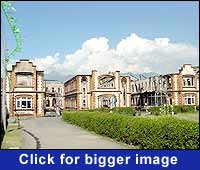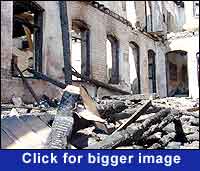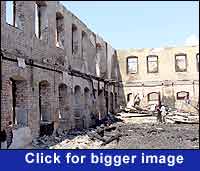

In 1891 a British missionary, Tyndale Biscoe, joined Kashmir's first British-run school imparting modern education to local students. The 250 students in the ten-year-old school were Brahmins who refused to play football, for touching leather would render them unholy. The Muslims refused to join; secular education, they feared, would turn them into infidels.
Biscoe did not budge. His Brahmins played football and rowed 'like low-caste boatmen.' Later, Muslim students followed and did not turn into infidels. Another man, very different man from Biscoe in his education, race, and world view, refuted the dogmas that were preventing the spread of modern education.
He could. Moulvi Rasool Shah was the Mirwaiz head priest of Srinagar.
 In 1899 Rasool Shah founded an organisation to promote education among the almost illiterate majority of Kashmiri Muslims. Anjuman-e-Nusrat-ul-Islam, or ANI, had a humble beginning in a cottage in the Rajouri Kadal locality of central Srinagar. By 1912 the Mirwaiz family had transformed the seminary into a school offering both secular and religious education.
In 1899 Rasool Shah founded an organisation to promote education among the almost illiterate majority of Kashmiri Muslims. Anjuman-e-Nusrat-ul-Islam, or ANI, had a humble beginning in a cottage in the Rajouri Kadal locality of central Srinagar. By 1912 the Mirwaiz family had transformed the seminary into a school offering both secular and religious education.
In the decades to come, ANI spread its networks of schools throughout Kashmir, enabling thousands to receive education. Kashmir's educational circles had a brand name: Islamia School.
I was travelling in rural Kashmir when news came that 'unidentified persons' had set Islamia School on fire (on July 5). News reports mentioned sabotage, and the possible use of petrol for burning the school. Motives found mention in an ambiguous language. Some believe it was a tactic by hardline militant groups to browbeat the school founder's descendant, Omar Farooq, present head priest and an influential member of the faction of the separatist Hurriyat Conference that has entered into a dialogue with the central government. Recently, unknown assassins shot his uncle, Moulvi Mushtaq Ahmed. Omar talks of removing the differences within the separatist camp. Politics will take its own course.
Back in Srinagar I found my way to the charred Islamia School. Armed policemen with automatic rifles stood guard. I remembered the school as an elegant, arcaded building with latticed windows and ceilings. Circled by featureless modernist brick houses, it stood out impressively with a Mughal-style garden in its compound, beyond which rose the ramparts of a
mediæval fort atop a hill overlooking the city. It is a different sight now.
The brick façade of the school with arcaded windows and gateways were covered in soot. The remains of the ornate wooden balconies were a few metre-long pieces of charcoal. The conical tin roof lay strewn over burnt chairs, almirahs, and tables in what was the school auditorium.
 I walked over damp charcoal through classrooms. The smell of smoke and charcoal hung in the air. The blackboards cemented into the wall were further blackened by soot. On a blackboard I found the last assignment from a teacher scribbled in chalk staring at me:
I walked over damp charcoal through classrooms. The smell of smoke and charcoal hung in the air. The blackboards cemented into the wall were further blackened by soot. On a blackboard I found the last assignment from a teacher scribbled in chalk staring at me:
03/07/2004 Subject: Maths
Homework: Write down the tables for 5, 6, 7 and 8
A half-burnt pile of answer papers lay beside a broken typewriter. The cover page of the answer book had the school's name and motto: Learning Blesseth Him Who Loveth Learning. I turned pages and found an essay on 'Being Punctual' by a class VI student. In another heap were pages from a book of essays for students; I glossed over essays on the Prophet Mohammed, Mahatma Gandhi, and Iqbal, the poet-philosopher. In the next room, remains of a computer lay next to a half-burnt book with Arabic verses and their Urdu translation. For I moment I feared it was a Quran. It turned out to be a collection of the Hadith -- the sayings of the Prophet, sacred to Muslims.
At the other end of the compound, a small barrack-like building houses the school principal's temporary office. He introduced himself as Dr M Y Wani, former student of the school and retired chief scientist of Sher-i-Kashmir University for Agricultural Science and Technology. "I am in shock," he said.
But the fire has not stopped the functioning of the classes. "We run classes in morning and afternoon shifts in this building," Dr Wani said. "We will continue with the mission of our founder. Twenty years back, we introduced coeducation here. Two years back, we got computers and had regular science labs for students. We were planning to get more scientific equipment when the tragedy occurred."
His sense of loss was evident as he turned nostalgic. "This institution educated the Muslims of Kashmir for three generations." He recalled the prominent pass-outs. Chief Minister Mufti Mohammad Sayeed, former chief minister Syed Mir Qasim, many high court judges, bureaucrats, and professors. "And Sheikh Abdullah was both a student and a science teacher here."
 Political differences strained relations between the followers of the Mirwaiz and the Sheikh after 1932. That was when the Sheikh converted the Jammu and Kashmir Muslim Conference into the secular National Conference against the wishes of the then Mirwaiz, Moulvi Yusuf Shah. But Wani's reference to the Sheikh did not surprise me; Kashmiris of all political shades do acknowledge his calibre whenever his name in mentioned in Kashmir.
Political differences strained relations between the followers of the Mirwaiz and the Sheikh after 1932. That was when the Sheikh converted the Jammu and Kashmir Muslim Conference into the secular National Conference against the wishes of the then Mirwaiz, Moulvi Yusuf Shah. But Wani's reference to the Sheikh did not surprise me; Kashmiris of all political shades do acknowledge his calibre whenever his name in mentioned in Kashmir.
But Mohammed Siddique Rishi, a frail 70-year-old clerk, reminded me that Sheikh Abdullah the science teacher became Sher-i-Kashmir partly because the school's founder's son and then Mirwaiz, Moulvi Yusuf Shah, promoted him. "Moulvi Saheb told the people, 'Follow Sheikh Abdullah,' and they followed him. Today Moulvi Saheb's school has been burnt. Politics consumed it." He cried.
Rishi recounted the story of how the school was built. He had heard the tale from his father.
There was not money enough for the building. So people kept earthen bins in their houses and put in a handful of rice every day. Shopkeepers kept collection boxes and asked every customer to donate an anna (a sixteenth part of a rupee). Every month this rice and money was collected. The rice was sold and the proceeds kept for building the school. That was a time when the population lived in abject poverty and excessive taxation from Maharaja Hari Singh and his revenue officials. "It was a labour of love," Rishi recalled.
The state government plans to restore the school. A group of engineers visited the site. "We will have to rebuild it as there are cracks in the walls," an engineer said.
 The principal told me a group of insurance surveyors would also be visiting. I asked him about the half-burnt pages of the book of Hadith I found and his face saddened. "We lost much more," he said. "We had a great collection of old manuscripts of Kashmir's religious and political history. We had a rare copy of the Quran handwritten by the third caliph of Islam, Usman. All that was burnt."
The principal told me a group of insurance surveyors would also be visiting. I asked him about the half-burnt pages of the book of Hadith I found and his face saddened. "We lost much more," he said. "We had a great collection of old manuscripts of Kashmir's religious and political history. We had a rare copy of the Quran handwritten by the third caliph of Islam, Usman. All that was burnt."
Peerzada Ashraf, an assistant director in the Jammu & Kashmir archives department, writing in a local daily, termed the collection of manuscripts at the Islamia School one of the richest Oriental collections. I thought of the engineers and the insurance agents visiting the school. Engineers cannot rebuild books and documents. Bricks and tin sheets can be bought, but not the burnt words. They have joined the list that details the lost heritage of Kashmir. The Quran written by the third caliph might fall between the burnt shrine of Chrar-e-Sharief and hundreds of books burnt in a fire in the 1990s at Islamia College, founded by the ANI not far from the school.
Photographs: Maleeha Mukhtar | Image: Rahil Shaikh
Basharat Peer, a former correspondent at rediff.com, is now working on his first book.





